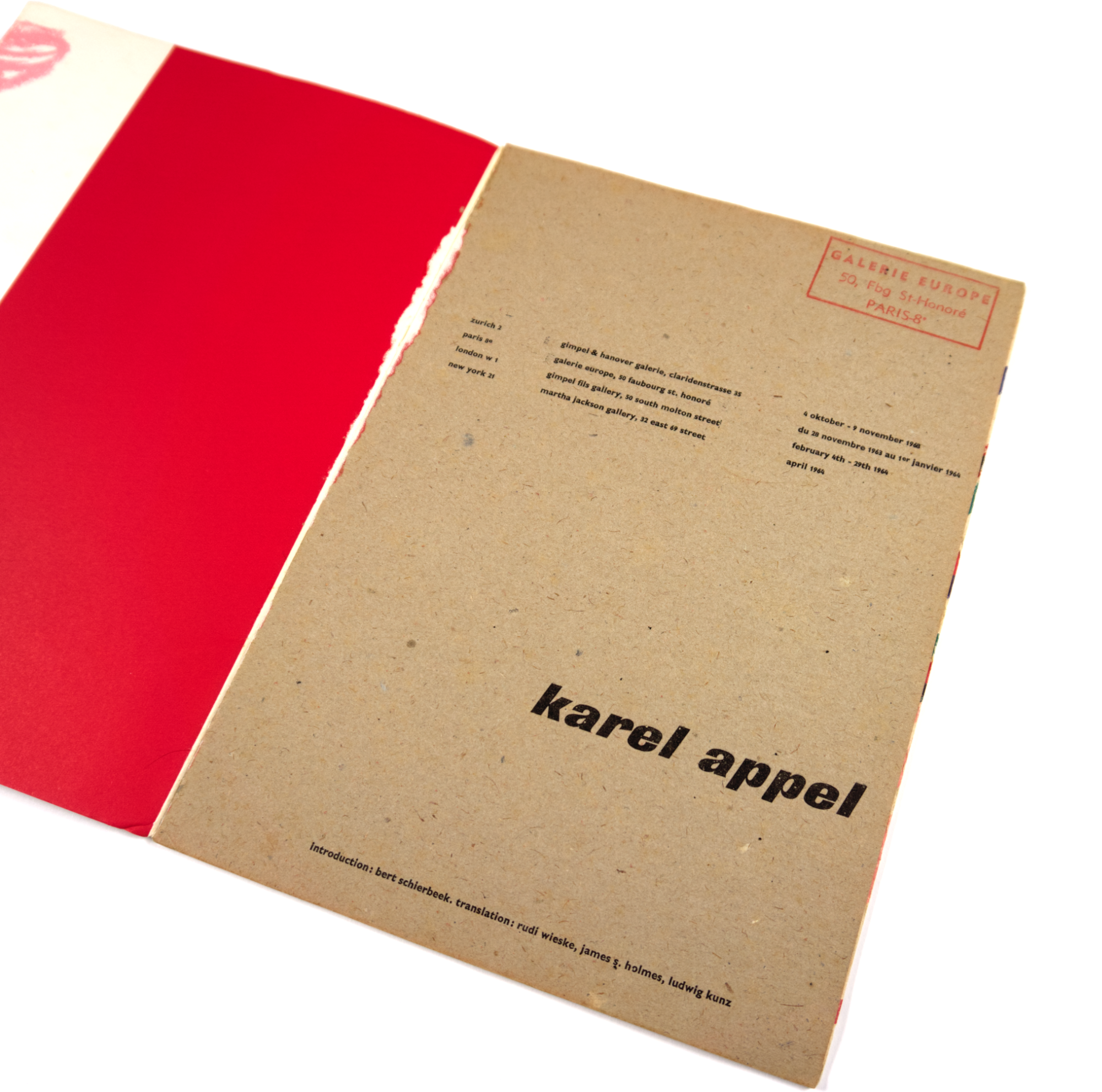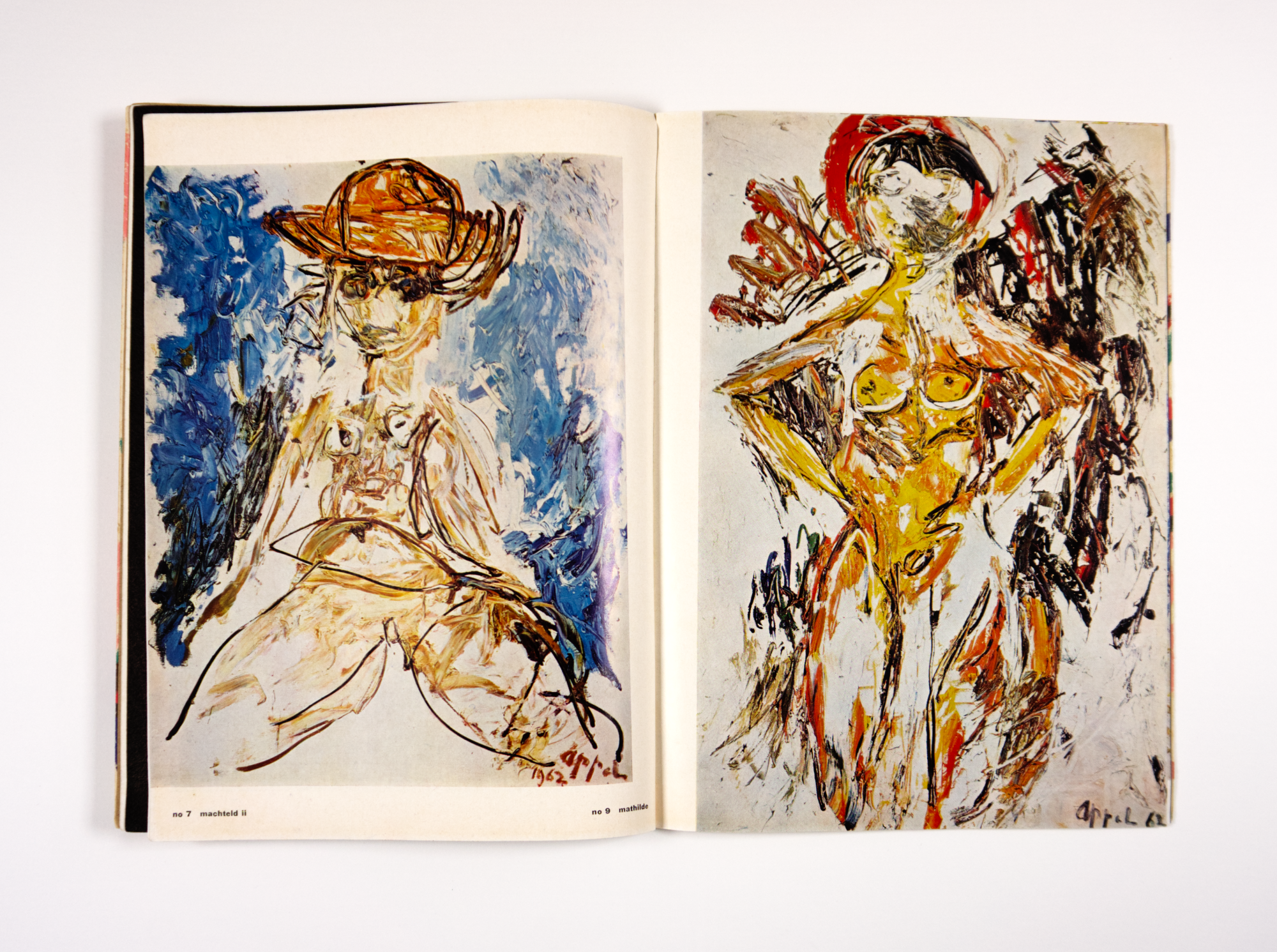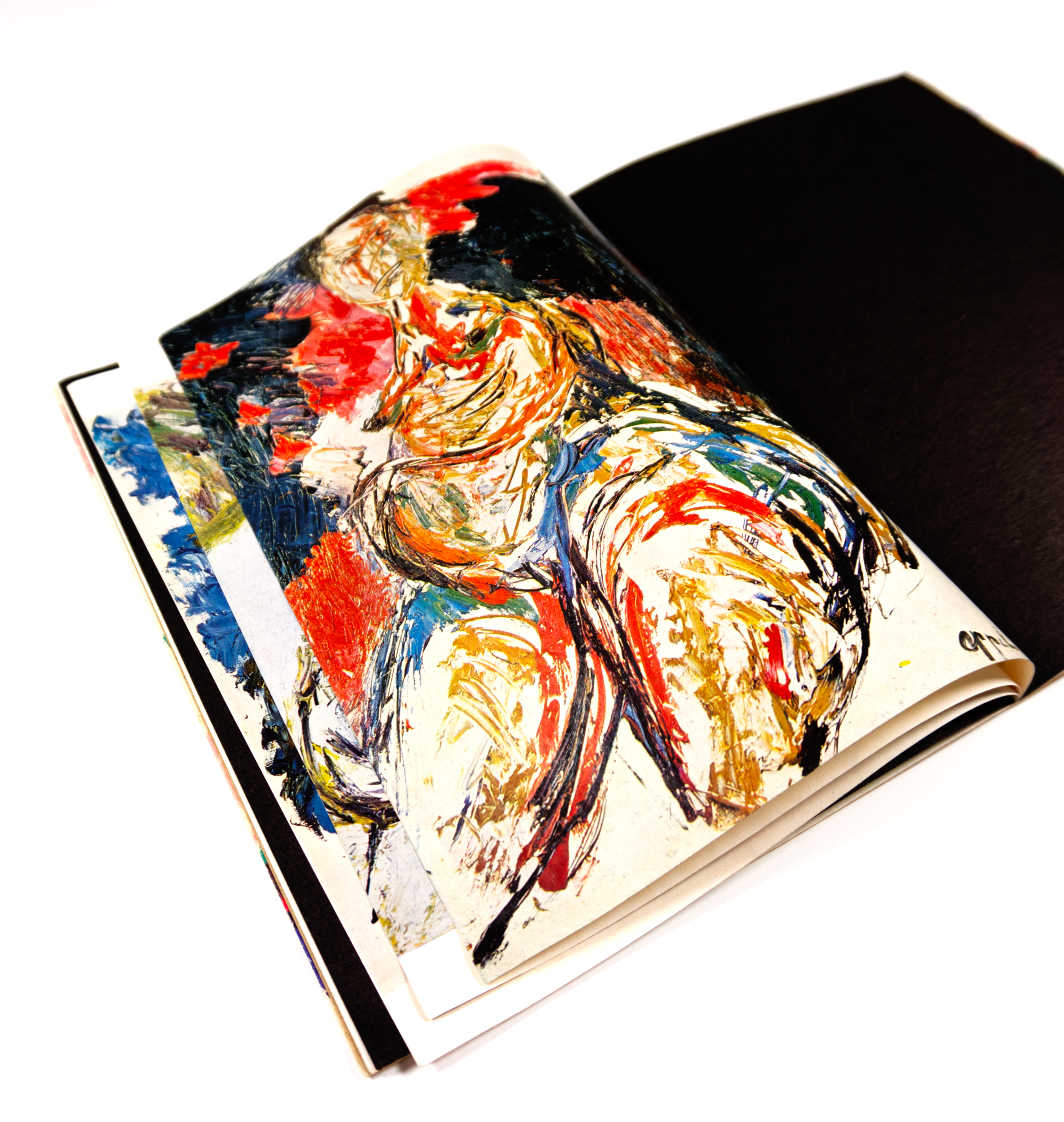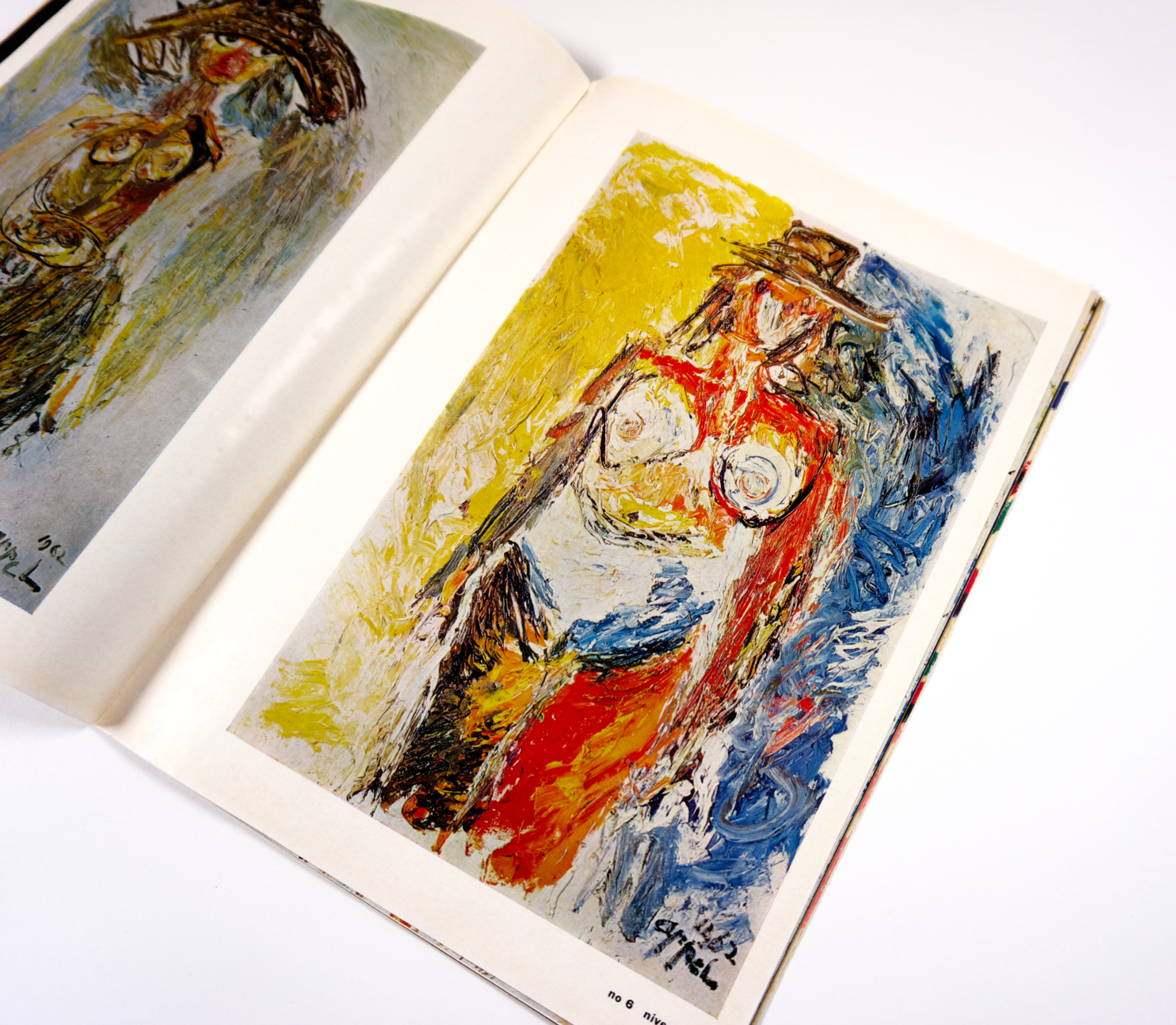 Image 1 of 8
Image 1 of 8

 Image 2 of 8
Image 2 of 8

 Image 3 of 8
Image 3 of 8

 Image 4 of 8
Image 4 of 8

 Image 5 of 8
Image 5 of 8

 Image 6 of 8
Image 6 of 8

 Image 7 of 8
Image 7 of 8

 Image 8 of 8
Image 8 of 8









Karel Appel: Nudes (1963)
Exhibition catalogue
Publisher: Gimpel & hanover galerie
Artist: Karel Appel (1921-2006)
Title: Appel Nudes
Publication date: 1963
Contributions: Bert Schierbeek and Karel Appel
Dimensions: 19 x 26 cm (7.48 x 10.24 in.)
Pages: Unpaginated
Edition: Single Edition
Notes: Includes a stamp from Galerie Europe
About
Published on the occasion of three Karel Appel exhibitions - in Zurich (1963), Paris and London (both 1964). With texts printed on brown fibrous paper stock entitled 'a propos des nues de karel appel' ('on appel's nudes'), by bert schierbeek, printed in English, French and German. Illustrated throughout in colour and black and white with text pages on a variety of paper stocks.
In the 1960s, Karel Appel’s Nudes exhibition showcased a series of raw, expressive paintings that reinterpreted the human figure with bold colors, heavy impasto, and gestural brushstrokes. Moving further into abstraction, Appel’s nudes appeared distorted and dynamic, exuding both sensuality and primal energy. Rather than idealizing the body, he emphasized movement and emotion, creating figures that seemed to pulse with life. The exhibition stirred intrigue and controversy, as his unrestrained approach challenged traditional representations of the nude, reinforcing his commitment to artistic freedom and pushing the boundaries of figuration and abstraction.
Karel Appel (1921-2006)
Karel Appel (1921–2006) was a Dutch painter, sculptor, and graphic artist known for his bold, expressive style that embodied the raw energy of the post-war avant-garde. As a co-founder of the CoBrA movement in 1948, Appel rejected academic traditions in favor of spontaneous, childlike forms and vivid colors. His works often featured distorted figures and animal-like shapes, rendered with thick impasto and dynamic brushstrokes, reflecting an untamed, almost primal energy. Deeply influenced by folk art and the works of children, his approach emphasized emotional intensity over formal precision, making his paintings and sculptures feel both playful and chaotic.
Throughout his career, Appel's work evolved from the early CoBrA experimentation to a more gestural and abstract style, yet he never abandoned his commitment to expressive freedom. His international success led him to work across various media, including murals, ceramics, and poetry, and his influence extended beyond Europe to the United States, where he gained recognition in the Abstract Expressionist circles. Despite occasional criticism for his unrestrained approach, Appel remained a fiercely independent artist, driven by an insatiable desire to create. His legacy endures in major museums worldwide, cementing his place as a key figure in 20th-century modern art.
Condition: Good overall condition (Integrity and authenticity). Signs of age and wear. First sheet slightly separated at the bottom (see photo).
Provenance: Acquired private collection (Portugal). Ownership: Monginho Collection.
Exhibition catalogue
Publisher: Gimpel & hanover galerie
Artist: Karel Appel (1921-2006)
Title: Appel Nudes
Publication date: 1963
Contributions: Bert Schierbeek and Karel Appel
Dimensions: 19 x 26 cm (7.48 x 10.24 in.)
Pages: Unpaginated
Edition: Single Edition
Notes: Includes a stamp from Galerie Europe
About
Published on the occasion of three Karel Appel exhibitions - in Zurich (1963), Paris and London (both 1964). With texts printed on brown fibrous paper stock entitled 'a propos des nues de karel appel' ('on appel's nudes'), by bert schierbeek, printed in English, French and German. Illustrated throughout in colour and black and white with text pages on a variety of paper stocks.
In the 1960s, Karel Appel’s Nudes exhibition showcased a series of raw, expressive paintings that reinterpreted the human figure with bold colors, heavy impasto, and gestural brushstrokes. Moving further into abstraction, Appel’s nudes appeared distorted and dynamic, exuding both sensuality and primal energy. Rather than idealizing the body, he emphasized movement and emotion, creating figures that seemed to pulse with life. The exhibition stirred intrigue and controversy, as his unrestrained approach challenged traditional representations of the nude, reinforcing his commitment to artistic freedom and pushing the boundaries of figuration and abstraction.
Karel Appel (1921-2006)
Karel Appel (1921–2006) was a Dutch painter, sculptor, and graphic artist known for his bold, expressive style that embodied the raw energy of the post-war avant-garde. As a co-founder of the CoBrA movement in 1948, Appel rejected academic traditions in favor of spontaneous, childlike forms and vivid colors. His works often featured distorted figures and animal-like shapes, rendered with thick impasto and dynamic brushstrokes, reflecting an untamed, almost primal energy. Deeply influenced by folk art and the works of children, his approach emphasized emotional intensity over formal precision, making his paintings and sculptures feel both playful and chaotic.
Throughout his career, Appel's work evolved from the early CoBrA experimentation to a more gestural and abstract style, yet he never abandoned his commitment to expressive freedom. His international success led him to work across various media, including murals, ceramics, and poetry, and his influence extended beyond Europe to the United States, where he gained recognition in the Abstract Expressionist circles. Despite occasional criticism for his unrestrained approach, Appel remained a fiercely independent artist, driven by an insatiable desire to create. His legacy endures in major museums worldwide, cementing his place as a key figure in 20th-century modern art.
Condition: Good overall condition (Integrity and authenticity). Signs of age and wear. First sheet slightly separated at the bottom (see photo).
Provenance: Acquired private collection (Portugal). Ownership: Monginho Collection.
Exhibition catalogue
Publisher: Gimpel & hanover galerie
Artist: Karel Appel (1921-2006)
Title: Appel Nudes
Publication date: 1963
Contributions: Bert Schierbeek and Karel Appel
Dimensions: 19 x 26 cm (7.48 x 10.24 in.)
Pages: Unpaginated
Edition: Single Edition
Notes: Includes a stamp from Galerie Europe
About
Published on the occasion of three Karel Appel exhibitions - in Zurich (1963), Paris and London (both 1964). With texts printed on brown fibrous paper stock entitled 'a propos des nues de karel appel' ('on appel's nudes'), by bert schierbeek, printed in English, French and German. Illustrated throughout in colour and black and white with text pages on a variety of paper stocks.
In the 1960s, Karel Appel’s Nudes exhibition showcased a series of raw, expressive paintings that reinterpreted the human figure with bold colors, heavy impasto, and gestural brushstrokes. Moving further into abstraction, Appel’s nudes appeared distorted and dynamic, exuding both sensuality and primal energy. Rather than idealizing the body, he emphasized movement and emotion, creating figures that seemed to pulse with life. The exhibition stirred intrigue and controversy, as his unrestrained approach challenged traditional representations of the nude, reinforcing his commitment to artistic freedom and pushing the boundaries of figuration and abstraction.
Karel Appel (1921-2006)
Karel Appel (1921–2006) was a Dutch painter, sculptor, and graphic artist known for his bold, expressive style that embodied the raw energy of the post-war avant-garde. As a co-founder of the CoBrA movement in 1948, Appel rejected academic traditions in favor of spontaneous, childlike forms and vivid colors. His works often featured distorted figures and animal-like shapes, rendered with thick impasto and dynamic brushstrokes, reflecting an untamed, almost primal energy. Deeply influenced by folk art and the works of children, his approach emphasized emotional intensity over formal precision, making his paintings and sculptures feel both playful and chaotic.
Throughout his career, Appel's work evolved from the early CoBrA experimentation to a more gestural and abstract style, yet he never abandoned his commitment to expressive freedom. His international success led him to work across various media, including murals, ceramics, and poetry, and his influence extended beyond Europe to the United States, where he gained recognition in the Abstract Expressionist circles. Despite occasional criticism for his unrestrained approach, Appel remained a fiercely independent artist, driven by an insatiable desire to create. His legacy endures in major museums worldwide, cementing his place as a key figure in 20th-century modern art.
Condition: Good overall condition (Integrity and authenticity). Signs of age and wear. First sheet slightly separated at the bottom (see photo).
Provenance: Acquired private collection (Portugal). Ownership: Monginho Collection.

